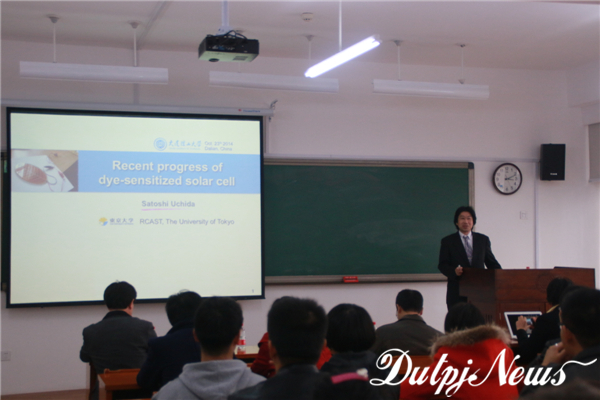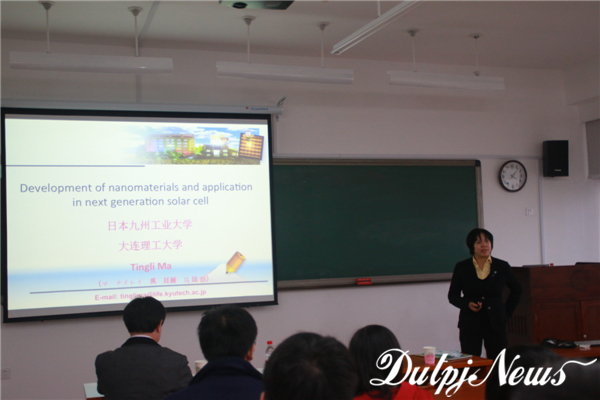10月23日下午,应科研与学科工作部邀请,来自东京大学的Satoshi Uchida和来自九州工业大学的马廷丽教授在A01S601教室为盘锦校区师生奉献了两场精彩的学术报告。报告由石油与化学工程学院副院长包明主持。科研与学科工作部副部长王万辉、石油与化学工程学院部分教师及科研与学科工作部工作人员参加了报告会。

Satoshi Uchida教授结合生动的动画演示,为师生们介绍了染料敏化电池的研发背景、近年来发展的态势、研究近况,并结合目前的新能源发展情况对染料敏化电池未来的研究方向及市场前景进行了预测和分析。

马廷丽教授介绍了替代传统材料的半导体及催化新材料的设计理念、制造方法、近年来的发展及团队成果。并从实用性角度,分析了开发纳米材料及新型有机和无机混合太阳能电池的前景。
交流环节中,参会师生们踊跃发言,分别用中、日、英三国语言向Satoshi Uchida和马廷丽教授提出自己的问题,Satoshi Uchida和马廷丽教授一一做了细致的解答,并欢迎我们的老师和学生去日本交流和学习。
新闻链接:
Prof. Satoshi Uchida
Academic background
1984.3 Aomori prefectural Hirosaki High School / Graduation
1988.3 Faculty of Engineering, Chemistry, Tohoku University /Graduation
1991.3 Graduate School of Engineering, Applied Chemistry, Tohoku University / Completion
1995.2 Doctor degree / Acquisition. Thesis title "Study of Ni, Cu, Zn, Sn leaching from metal scrap by hot aqueous solution"
Research and business career
1991.4 Research Institute of Mineral Dressing and Metallurgy (SENKEN),Tohoku University / Research Associate Extraction and leaching of metals from ore by hydrothermal process
1994.4 Institute for Advanced Materials Processing (IAMP), Tohoku University / Research Associate, Hydrothermal synthesis of various metal oxides.
1996.4 Institute for Chemical Reaction Science (ICRS), Tohoku University/ Research Associate, Hydrothermal synthesis of TiO2 and their photochemistry.
2001.4 Institute of Multidisciplinary Research for Advanced Materials (IMRAM), Tohoku University / Research Associate, Synthesis of nano
crystalline TiO2 and their application for dye-sensitized solar cells. 2006.11 Research Center for Advanced Science and Affiliated organization
E-mail:uchida@rcast.u-tokyo.ac.jp
马廷丽教授
Education and Work experience
1984 B.S.Department of Chemistry, Faculty of Science,Liaoning Normal University,China
1996 M.S.Department of Chemistry, Faculty of Science, Kyushu University, Japan
1999 Ph. D. Department of Chemistry, Faculty of Science, Kyushu University, Japan
1999 Postdoc. National Institute of Advanced Industrial Science and Technology (AIST),Japan
2004 Assoc. Prof. Kyushu University, Department of Chemistry, Japan
2006 Visiting Researcher. California Institute Technology, US and Imperial College London, UK
2007-present Professor,State Key Lab.of Fine Chemicals, Dalian University of Technology, China
2013-present Professor,Graduate School of Life Science and Systems Engineering,Kyushu Institute of Technology, Japan
Awards andHonours
1.Dalton Transaction Poster Prize at the 2ndAsian Conference on the Coordination Chemistry, Najiang, China, 2011
2.Best Paper Awardat 2011 Annual Conference of China Renewable Energy Society, 2011
3.Best Paper Awardat 6thConference of Functional Materials and Application and International Symposium on Functional Materials, 2007
4.Chemistry Award at 43thScientific Meeting of the Federation of Kyushu Societies for Foreign Researcher, 2006
5.2010.8 : Organizer of the 5thAseanian Conference on Dye-sensitized and Organic Solar Cells
6.2005-2007,Managing Director,The Japan Society for Analytical Chemistry, Kyushu Branch
7.2007-Present, Council,China Energy Society
ResearchPrograms
1.The National Natural Science Foundation of China (Grant No. 50773008)
2.State Key Laboratory of New Ceramic and Fine Processing (Tsinghua University).
3.The National High Technology Research and Development Program for Advanced Materials of China (Grant No. 2009AA03Z220)
4.The Program of theNewSunshineProject andNewTrend of PV R&DProgram in Japan
5.The Program ofthe Japan Science and Technology Agency (JST)
Professional Activities
Prof. Ma’s main research interests include photovoltaic devices, photocatalysis, hydrogen production, environmental pollution control, and the related materials and devices development.
Dye-sensitized solar cells(DSCs) havebeen attracting much attention due totheirhigh-energy conversion efficiency andas alow-cost alternative to commercial solar cells based on silicon.In order to successfully commercialize DSCs, it is necessary to further improve the energy conversion efficiencyand lifetime.Her group interests includethe followingfields:(1)Syntheses of neworganic and inorganicsemiconductor sensitizers; (2)Modified semiconductor nano-materials, such as N-doped titaniato furtherimprovethe efficiency of DSCs; (3)The development oflow-cost, highly efficientnew counter electrodes; (4) The study of supermolecular photoelectric devices; (5) The studies of polymer dispersant for the industrial print of the thin film electrodes and thelarge-scaleDSCs modules; (6) The study of new tandemstructure of DSCs.
Solar hydrogen production isavery attractive way to harvestand store solar energy. It is well known that a combination process of photovoltaic cell and water electrolysis isapractical way to solar hydrogen production.Wefocused onphotocatalytic water splittingusing oxide semiconductor powders.Wearealso carrying out solar hydrogen production usingasystem composed of an oxide semiconductor photoelectrode and adye-sensitized solar cell.
|